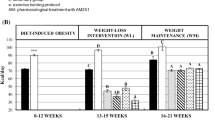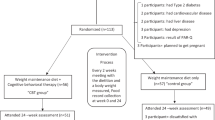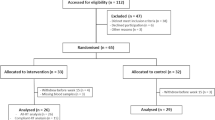Abstract
OBJECTIVE: Trp64Arg mutation in the β3-adrenergic receptor (β3AR) gene is relatively common in Japanese people. However, it has not been clear whether persons with Trp64Arg mutation in the β3AR gene tend to have obesity and difficulty in losing weight even with a restricted diet and exercise. We investigated the response of body weight and metabolic factors to behavioral intervention in Japanese women with Trp64Arg mutation in the β3AR gene.
DESIGN: A 3-month behavioral intervention study using a combination of diet and exercise programs.
SUBJECTS: A total of 76 perimenopausal women with no clinical symptoms (age: 54.7±7.7 y, body mass index (BMI): 21.0–33.0 kg/m2).
MEASUREMENTS: Anthropometric measurements (weight, height, body fat, waist circumference, hip circumference, skin fold, resting energy expenditure and blood pressure) and metabolic measurements (serum levels of cholesterol, triglyceride, phospholipid, nonesterified fatty acid, glucose, insulin and leptin) and determination of the β3AR genotype by polymerase chain reaction followed by BstNI digestion.
RESULTS: At the baseline of BMI, body weight, body fat, waist circumference, hip circumference, the arm skin fold, resting energy expenditure, or blood lipid and glucose profiles, there was no significant difference in participants with/without mutation of the β3AR gene. The intervention yielded a body weight reduction in 69 and 48%, and induced a significant difference in weight loss (−0.74 and −0.01 kg) for women with wild-type and Trp64Arg mutation, respectively. Significant differences of anthropometric parameters were found in body weight, BMI, waist and hip circumferences and blood pressure of wild type by the intervention. However, women with Trp64Arg mutation did not show significant changes in these anthropometric parameters, except for hip circumference. A significant difference was found in high-density lipoprotein cholesterol (HDL-C) and in the low-density lipoprotein cholesterol/HDL-C ratio in both genotypes.
CONCLUSION: The results of the present study suggest that the Trp64Arg mutation of the β3AR gene is associated with difficulty in losing weight through behavioral intervention, although it is not related to obesity-related phenotypes and resting energy expenditure before the intervention.
This is a preview of subscription content, access via your institution
Access options
Subscribe to this journal
Receive 12 print issues and online access
$259.00 per year
only $21.58 per issue
Buy this article
- Purchase on Springer Link
- Instant access to full article PDF
Prices may be subject to local taxes which are calculated during checkout

Similar content being viewed by others
References
Public Health Service. The Surgeon General's report on nutrition and health. DHHS publication (PHS) 88-50210. US Department of Health and Human Services: Washington, DC; 1988.
Report of a WHO Consultation. Obesity: preventing and managing the global endemic. WHO Technical Report Series, No. 894. WHO: Geneva, 2000.
Curb JD, Marcus EB . Body fat and obesity in Japanese Americans. Am J Clin Nutr 1991; 53: 1552S–1555S.
Goto Y, Yamaguchi Y . Epidemiology of obesity. Nihon Rinsho 1993; 51(Supp l): 247–257 (in Japanese).
Ohmura T, Ueda K, Kiyohara Y, Kato I, Iwamoto H, Nakayama K, Nomiyama K, Ohmori S, Yoshitake T, Shinkawa A, Hasuo Y, Fujishima M . Prevalence of type 2 (non-insulin-dependent) diabetes mellitus and impaired glucose tolerance in the Japanese general population: the Hisayama study. Diabetologia 1993; 36: 1198–1203.
Tokunaga K, Matsuzawa Y, Kotani K, Keno Y, Kobatake T, Fujioka S, Tarui S . Ideal body weight estimated from the body mass index with the lowest morbidity. Int J Obes Relat Metab Disorder 1991; 15: 1–5.
Arner P . Hunting for human obesity genes? Look in the adipose tissue!. Int J Obes Relat Metab Disorder 2000; 24: S57–S62.
Walston J, Silver K, Bogardus C, Knowler WC, Celi FS, Austin S, Manning B, Strosberg AD, Stern MP, Raben N . Time of onset of non-insulin-dependent diabetes mellitus and genetic variation in the β3-adrenergic-receptor-gene. N Engl J Med 1995; 333: 343–347.
Fujisawa T, Ikegami H, Kawaguchi Y, Ogihara T . Meta-analysis of the association of Trp64Arg polymorphism of β3-adrenergic receptor gene with body mass index. J Clin Endocrinol Metab 1998; 83: 2441–2444.
Katzmarzyk P, Perusse L, Bouchard C . Genetics of abdominal visceral fat levels. Am J Hum Biol 1999; 11: 225–235.
Lofontan M, Berlan M . Fat cell adrenergic receptors and the control of white and brown fat cell function. J Lipid Res 1993; 34: 1057–1091.
Zaagsma J, Nahorski SR . Is the adipocyte β-adrenoceptor a prototype for the recently cloned atypical β3-adrenoceptor? Trends Pharmacol Sci 1990; 11: 3–7.
Clement K, Vaisse C, Manning BJ, Basdevant A, Guy-Grand B, Ruiz J, Silver KD, Shuldiner AR, Froguel P, Strosberg AD . Genetic variation in the β3-adrenergic receptor and an increase capacity to gain weight in patient with morbid obesity. N Engl J Med 1995; 333: 352–354.
Widen E, Lehto M, Kanninen T, Walston J, Shuldiner AR, Groop LC . Association of a polymorphism in the β3-adrenergic-receptor-gene with features of the insulin resistance syndrome in Finns. N Engl J Med 1995; 333: 348–351.
Groop LC . Insulin resistance: the fundamental trigger of type 2 diabetes. Diabetes Obes Metab 1999; 1: S1–S7.
Luke A, Durazo-Arvizu R, Rotimi C, Prewitt TE, Ferrester T, Wilks R, Ogunbiyi OJ, Schoeller DA, McGee D, Cooper RS . Relation between body mass index and body fat in black population samples from Nigeria, Jamaica, and the United States. Am J Epidemiol 1997; 145: 620–628.
Kodowaki H, Yasuda K, Iwamoto K, Otabe S, Shimokawa K, Silver K, Walston J, Yoshinaga H, Kosaka K, Yamada N, Saito Y, Hagura R, Akanuma Y, Shuldiner A, Yazaki Y, Kadowaki T . A mutation in the β3-adrenergic receptor gene is associated with obesity and hyperinsulinemia in Japanese subjects. Biochem Biophys Res Commun 1995; 215: 555–560.
Yoshida T, Sakane N, Umekawa T, Sakai M, Takahashi T, Kondo M . Mutation of β3-adrenergic receptor of obesity. Lancet 1995; 246: 1433–1434.
Gagnon J, Mauriege P, Roy S, Sjostrom D, Chagnon YC, Dionne FT, Oppert JM, Perusse L, Sjostrom L, Bouchard C . The Trp64Arg mutation of the β3-adrenergic receptor gene has no effect on obesity phenotypes in the Quebec Family Study and Swedish Obese Subjects Cohorts. J Clin Invest 1996; 98: 2086–2093.
Awata T, Katayama S . Genetic variation in the β3-adrenergic receptor in Japanese NIDDM patients. Diabetic Care 1996; 19: 271–272.
Ueda K, Tanizawa Y, Oota Y, Inoue H, Kizuki N, Inoue H, Tsukuda K, Asano T, Oka Y . Prevalence of the Trp64Arg missense mutation of the β3-adrenergic receptor gene in Japanese subjects. Metabolism 1997; 46: 199–202.
Kurokawa N, Nakai K, Kameo S, Liu ZM, Satoh H . Association of BMI with the β3-adrenergic receptor gene polymorphism in Japanese: meta-analysis. Obes Res 2001; 9: 741–745.
Allison DB, Heo M, Faith MS, Pietrobelli A . Meta-analysis of the association of the Trp64Arg polymorphism in the β3-adrenergic receptor with body mass index. Int J Obes Relat Metab Disord 1998; 22: 559–566.
Shiwaku K, Gao TQ, Isobe A, Fukushima T, Yamane Y . A Trp64Arg mutation in the β3-adrenergic receptor gene is not associated with moderate overweight in Japanese workers. Metabolism 1998; 47: 1528–1530.
The National Heart Lung and Blood Institute Obesity Education Initiative Expert Panel. Clinical guidelines on the identification, evaluation, and treatment of overweight and obesity in adults. National Institute of Health Publication No. 98-4083. NIH: Bethesda, 1998.
National Institute of Health Technology Assessment Conference Panel. Methods for voluntary weight loss and control. Anal Intern Med 1992; 116: 942–949.
Latner LD . Self-help in the long-term treatment of obesity. Obes Rev 2001; 2: 87–97.
Wing RR, Sallis Jr J, Goldstein GM, Smith-West D, Action JK, Jeffery WB, Birch LL, Surwit SR, Jakicic MJ . Behavioral science research in diabetes. Diabetes Care 2001; 24: 117–123.
Morimoto A, Takase Y, Hada K, Hosoya N . Evaluation of a ‘convenient method’ for the estimation dietary food consumption. Jpn J Nutr 1977; 35: 235–245. (in Japanese).
Resources Council, Science and Technology Agency, Standard tables of food composition in Japan, 5th revised edn. Printing Bureau, Ministry Finance, Tokyo (in Japanese).
Utter AC, Nieman DC, Ward AN, Butterworth DE . Use of the leg-to-leg bioelectrical impedance method in assessing body-composition change in obese women. Am J Clin Nutr 1999; 69: 603–607.
Stevens-Simon C, Thureen P, Barrett J, Stamm E . Skinfold caliper and ultrasound assessments of change in the distribution of subcutaneous fat during adolescent pregnancy. Int J Obes Relat Metab Disord 2001; 25: 1340–1345.
Nagamine S . Standard of obesity. Jpn J Med Assoc 1972; 68: 916–932. (in Japanese).
VINE Corp. The instruction manual of nondispersive infrared analysis. VINE Corp: Tokyo; 2000 (in Japanese).
Matthews DR, Hosker JP, Rudenski AS, Naylor BA, Treacher DF, Turner RC . Homeostasis model assessment: insulin resistance and beta-cell function from fasting plasma glucose and insulin concentrations in man. Diabetologia 1985; 28: 412–419.
Jequier E, Tappy L . Regulation of body weight in humans. Physiol Rev 1999; 79: 461–480.
Tchernof A, Starling RD, Turner A, Shuldiner AR, Walston JD, Silver K, Poehlman ET . Impaired capacity to lose visceral adipose tissue during weight reduction in obese postmenopausal women with the Trp64Arg β3-adrenoceptor gene variant. Diabetes 2000; 9: 1709–1713.
Benecke H, Topak H, von zur Mullen A, Schuppert F . A study on the genetics of obesity: influence of polymorphisms of the β3-adrenergic receptor and insulin receptor substrate 1 in relation to weight loss, waist to hip ratio and frequencies of common cardiovascular risk factors. Exp Clin Endocrinol Diabetes 2000; 108: 86–92.
Sipilainen R, Uusitupa M, Heikkinen S, Rissanen A, Laakso M . Polymorphism of the β3-adrenergic receptor gene affect basal metabolic rate in obese Finns. Diabetes 1997; 46: 77–80.
Tchernof A, Starling RD, Walston JD, Shuldiner AR, Dvorak RV, Silver K, Matthews DE, Poehlman ET . Obesity-related phenotypes and the β3-adrenoceptor gene variant in postmenopausal women. Diabetes 1999; 48: 1425–1428.
Kurabayashi T, Carey DGP, Morrison NA . The β3-adrenergic receptor gene Trp64Arg mutation is overrepresented in obese women; effects of weight, BMI, abdominal fat, blood pressure, and reproductive history in an elderly Australian population. Diabetes 1996; 45: 1358–1363.
Kaplan MN . The deadly quartet, upper-body, glucose intolerance, hypertriglyceridemia, and hypertension. Arch Intern Med 1989; 149: 1514–1520.
Thomas GN, Tomlinson B, Chan JCN, Young RP, Critchley JAJH . The Trp64Arg polymorphism of β3-adrenergic receptor gene and obesity in Chinese subjects with components of the metabolic syndrome. Int J Obes Relat Metab Disord 2000; 24: 545–551.
Kushner RF, Kunigk A, Alspaugh M, Andronis PT, Leitch CA, Schoeller DA . Validation of bioelectrical-impedance analysis as a measure of change in body composition in obesity. Am J Clin Nutr 1990; 52: 219–223.
Lukaski HC . Requirements for clinical use of bioelectrical impedance analysis (BIA). Ann NY Acad Sci 1999; 873: 72–76.
Acknowledgements
This study was supported in part by Grants-in-Aid (12670355, 14570334 to KS, 13680173 to AN) for Scientific Research from the Japanese Ministry of Education, Culture, Sports, Science and Technology, and Grants from the Japanese Ministry of Health, Labor and Welfare (to YY).
Author information
Authors and Affiliations
Corresponding author
Rights and permissions
About this article
Cite this article
Shiwaku, K., Nogi, A., Anuurad, E. et al. Difficulty in losing weight by behavioral intervention for women with Trp64Arg polymorphism of the β3-adrenergic receptor gene. Int J Obes 27, 1028–1036 (2003). https://doi.org/10.1038/sj.ijo.0802375
Received:
Revised:
Accepted:
Published:
Issue Date:
DOI: https://doi.org/10.1038/sj.ijo.0802375
Keywords
This article is cited by
-
UCP2 expression is associated with weight loss after hypocaloric diet intervention
European Journal of Clinical Nutrition (2017)
-
Behavioral and Environmental Modification of the Genetic Influence on Body Mass Index: A Twin Study
Behavior Genetics (2015)
-
Effects of exercise training on gut hormone levels after a single bout of exercise in middle-aged Japanese women
SpringerPlus (2013)
-
Beta-3-adrenergic receptor Trp64Arg polymorphism: does it modulate the relationship between exercise and percentage of body fat in young adult Japanese males?
Environmental Health and Preventive Medicine (2013)
-
Charting a course for genomic medicine from base pairs to bedside
Nature (2011)



